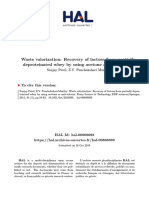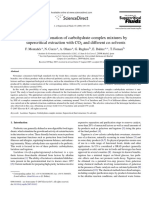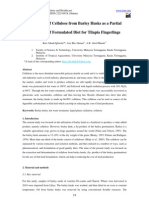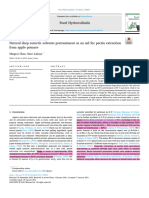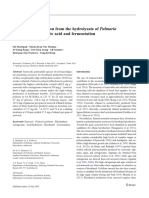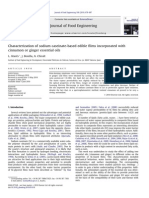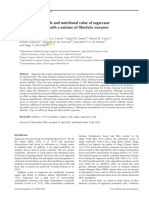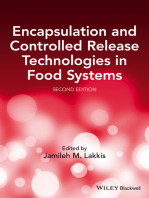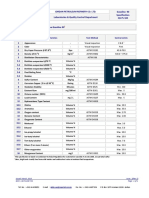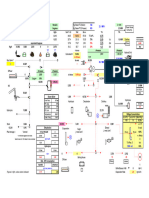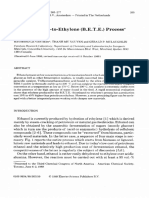Food-Chemistry 2011 128 773
Food-Chemistry 2011 128 773
Uploaded by
Brenda C RoldánCopyright:
Available Formats
Food-Chemistry 2011 128 773
Food-Chemistry 2011 128 773
Uploaded by
Brenda C RoldánOriginal Title
Copyright
Available Formats
Share this document
Did you find this document useful?
Is this content inappropriate?
Copyright:
Available Formats
Food-Chemistry 2011 128 773
Food-Chemistry 2011 128 773
Uploaded by
Brenda C RoldánCopyright:
Available Formats
Food Chemistry 128 (2011) 773777
Contents lists available at ScienceDirect
Food Chemistry
journal homepage: www.elsevier.com/locate/foodchem
Short communication
Galactosyl oligosaccharide purication by ethanol precipitation
Dwaipayan Sen a, Aaron Gosling b,c, Geoff W. Stevens b, Prashant K. Bhattacharya d, Andrew R. Barber e, Sandra E. Kentish b, Chiranjib Bhattacharjee a, Sally L. Gras b,c,
a
The Department of Chemical Engineering, Jadavpur University, Kolkata 700 032, India The Department of Chemical and Biomolecular Engineering, The University of Melbourne, Victoria 3010, Australia c The Bio21 Molecular Science and Biotechnology Institute, The University of Melbourne, Victoria 3010, Australia d Department of Chemical Engineering, Indian Institute of Technology Kanpur, Kanpur 208016, India e Innovative Food and Plants Division, South Australian Research and Development Institute, Regency International Centre, Days Road, Regency Park, SA 5010, Australia
b
a r t i c l e
i n f o
a b s t r a c t
Galactosyl oligosaccharides (GOS) are prebiotics commonly manufactured by b-galactosidase conversion of lactose, producing a mixture containing GOS, lactose, glucose and galactose. Enrichment of GOS in this mixture adds value to the product. This study aimed to determine whether the addition of ethanol to aqueous saccharide solutions could be used to selectively precipitate and enrich GOS from a reaction mixture. High concentrations of ethanol (>70% v/v) were required to induce precipitation. The total saccharide concentration was a signicant variable, with higher GOS enrichment occurring at lower total saccharide concentrations. Varying the temperature between 10 and 40 C had less impact than had changes in the concentration of saccharide or ethanol. GOS was enriched 2.3 (0.1) fold in the precipitate formed in a solution of 90% (v/v) ethanol with 28 g/L of total saccharide at 40 C. Performing two such precipitations sequentially reduced the monosaccharides from 48% (w/w) of the total saccharides to 4% (w/w). GOS precipitation has potential for industrial application as it is simple in operation and offers levels of purication similar to those by other techniques. 2011 Elsevier Ltd. All rights reserved.
Article history: Received 9 August 2010 Received in revised form 10 February 2011 Accepted 16 March 2011 Available online 22 March 2011 Keywords: Galactosyl oligosaccharide GOS Prebiotic Saccharide precipitation
1. Introduction Galactosyl oligosaccharides (GOS) are an example of a prebiotic food ingredient that allows specic changes both in the composition and/or activity in the gastrointestinal microora that confers benets upon host well being and health (Macfarlane, Steed, & Macfarlane, 2008; Roberfroid, 2007). The global retail market for prebiotic foods is large and growing in size, with recent estimates of an annual 167,000 ton and 390 million Euro market (Siro, Kpolna, Kpolna, & Lugasi, 2008). GOS are produced from lactose by the enzyme b-galactosidase (Gosling, Stevens, Barber, Kentish, & Gras, 2010). This complex reaction system produces a mixture of GOS, along with the monosaccharides glucose and galactose, which are not considered prebiotic (Roberfroid, 2007). The product mixture typically also contains unreacted lactose. Isolating GOS would add value by increasing the prebiotic efcacy per unit mass while reducing caloric value and cariogenicity. Such purication would also change the functional properties of the product mixture by lowering hygroscopicity and
Corresponding author at: The Department of Chemical and Biomolecular Engineering, The University of Melbourne, Victoria 3010, Australia. Fax: +61 3 8344 4153. E-mail address: sgras@unimelb.edu.au (S.L. Gras).
0308-8146/$ - see front matter 2011 Elsevier Ltd. All rights reserved. doi:10.1016/j.foodchem.2011.03.076
sweetness as well as increasing viscosity (Crittenden & Playne, 2002). Many GOS purication strategies have been reported. Large scale continuous ion-exclusion chromatography has long been applied to processing of sucrose (Bubnik et al., 2004) and purifying of lactose (Harju & Heikkila, 1990) and a semi-continuous ion-exclusion chromatography process has been patented for GOS purication (Sinclair, De Slegte, & Klarenbeek, 2008). Supercritical uid extraction (SFE) has achieved 75% (w/w) GOS purity with 94% (w/w) recovery (Montas, Olano, Reglero, Ibez, & Fornari, 2009). Nanoltration (NF) recovered 98% of the GOS from a commercial GOS syrup (Vivinal GOS) but also retained 18% of monosaccharide (Goulas, Kapasakalidis, Sinclair, Rastall, & Grandison, 2002). Microbes such as Saccharomyces cerevisiae (Goulas, Tzortzis, & Gibson, 2007) and Zymomonas mobilis (Crittenden & Playne, 2002) selectively consume up to 90% of monosaccharides present in saccharide mixtures, effectively enriching lactose and oligosaccharides. Exploiting differences in solubility to purify components of mixtures is a common approach, with the generic advantage over the above techniques of simplicity and cost effectiveness during scale up. This approach has been extensively studied for purifying lactose (Bourne, Hegglin, & Prenosil, 1983; Gnzle, Haase, & Jelen, 2008). GOS purication through the exploitation of differential solubility has not to our knowledge been reported.
774
D. Sen et al. / Food Chemistry 128 (2011) 773777
This study aimed to develop a simple, scalable method, to separate GOS from mono- and di-saccharides, based on precipitation. An ethanolwater system was selected as it allows the preparation of food-grade products. The enrichment and recovery of GOS, at varied saccharide concentrations and temperatures, was assessed at different ethanol concentrations. 2. Materials and methods 2.1. Enzymes and chemicals The b-galactosidase enzyme preparation, Biolacta FN5, was kindly supplied by Vitachem, Sydney, Australia. Lactose monohydrate, D-glucose (Chem Supply, Gillman, Australia), D-galactose (SigmaAldrich, Sydney, Australia) and ethanol (Merck, Kilsyth, Australia) were of analytical grade. Rafnose pentahydrate (SigmaAldrich, Sydney, Australia) was P99%. Milli Q water (resistivity < 18.2 Ohm) was used. 2.2. Preparation of the saccharide feedstock To produce a stable feedstock for solubility experiments, that was representative of GOS reaction products, Biolacta FN5 (1 g) was added to a 2 L solution of 10 mM sodium acetate buffer, at pH 6.6, containing 100 g/L of lactose monohydrate. The reaction was allowed to proceed for 17.5 h at 40.0 0.1 C. To stop the reaction, the enzyme was separated from the reaction mixture, using ultraltration in a cross-ow membrane module (Osmonics Sepa CF II Cell), equipped with a 15 kDa membrane (HFK-131 from Koch Membrane Systems, Australia). Ultraltration was performed until the retentate was concentrated by a volume factor (VCF) of 4 and the permeate containing the sugars further processed. An enzyme activity assay (Fujimoto, Miyasato, Ito, Sasaki, & Ajisaka, 1998) showed that all b-galactosidase had been removed from the permeate. A rotary evaporator was used to concentrate the permeate before freeze-drying (Dynavac FD5 operating below 10 Torr at 22 C). The reduced water content of the resultant saccharide syrup allowed experiments at high saccharide and ethanol concentrations. It also provided a mimic for commercial GOS products (e.g. Vivinal GOS), which are supplied as concentrated syrups. 2.3. Saccharide precipitation The saccharide syrup, obtained after freeze-drying, was diluted by the addition of 100 mL of water to 300 g of syrup, producing a feedstock, found by high performance liquid chromatography (HPLC), to contain 62 1% w/w of saccharides (composition shown in Table 1). Aqueous saccharide solutions, at three concentrations (280, 600 and 810 g/L) were prepared, with densities of 1.08 0.02, 1.21 0.05 and 1.30 0.07 g/mL, respectively. Aliquots (0.5 mL) of each saccharide solution were diluted to the nal concentrations of 28, 60 and 81 g/L by adding 4.5 mL of ethanol and water. For example, when 90% (v/v) ethanol was required, 4.5 mL of neat ethTable 1 Composition of saccharide feedstock. Saccharide GOS Lactose Glucose Galactose Percentage of total saccharidea 16 37 30 18 (1.7) (2.1) (1.0) (0.8)
anol was added to the 0.5 mL saccharide solution aliquot. These solutions were incubated for 16 h at 40, 25 or 10 C, with orbital shaking at 60 rpm in sealed tubes to minimise evaporation. After incubation, samples were withdrawn and centrifuged at 13,000g for 3 min to separate any precipitated solids. The supernatant was diluted twofold with Milli Q water before analysis by HPLC. For sequential precipitations, solid material, precipitated in 90% (v/v) ethanol at 28 g/L of total saccharide and 40 C, was redissolved to 28 g/L of total saccharide with water before performing the precipitation again. 2.4. HPLC analyses HPLC analysis of carbohydrates was performed as previously described (Gosling et al., 2009). Saccharides were separated using a Shimadzu Prominence HPLC with a 300 7.8 mm Rezex RCMMonosaccharide Ca2+ column (Phenomenex). The Milli Q water mobile phase ow rate was 0.5 mL/min and saccharides were detected with a RID-10A refractive index detector. The column and detector cell were maintained at 80 and 40 C, respectively. Saccharides were quantied using external standards of analytical grade galactose, glucose and lactose. GOS was quantied using rafnose as a standard. 2.5. Calculations The mass and composition of the precipitate generated by each treatment were estimated by performing a mass balance (Eq. (1)). In order to calculate this mass balance, all test solutions were incubated in parallel to a reference solution containing 50% (v/v) ethanol. A preliminary study found that 50% (v/v) ethanol was insufcient to cause precipitation at any combination of temperature and saccharide concentration examined. The mass of each saccharide found in the solution phase of test solutions (Masstreated) was subtracted from the mass of saccharide found in the reference solution (Massreference) to give the mass of that individual saccharide in the precipitate (Massppt)
Massreference Masstreated Massppt
The mass of saccharide present in the precipitate was then used to calculate metrics for assessing each treatment (Eqs. (2)(4))
Percentage Recovery of GOS 100
GOS Massppt Initial GOS Mass
To calculate the fold enrichment (Eq. (3)), the mass fraction of GOS present in the saccharide feedstock (0.16 0.017 g of GOS per gram of total saccharide) (Table 1) was used in the denominator
Fold Enrichment of GOS GOS Massppt =Total Saccharide Massppt Initial GOS Mass=Initial Total Saccharide Mass GOS Massppt Lac Massppt 3
GOS : Lac 100
a Mean of six samples taken from the feedstock with standard deviations in parentheses.
Experimental error was assessed by performing triplicate precipitations at each of the saccharide concentrations (28, 60 and 81 g/L) and 40 C. The standard deviation of the mean concentration of GOS, lactose, glucose and galactose was less than 1.2 g/L for each saccharide. The percentage of the mean GOS recovery, enrichment and GOS:Lac, represented by the standard deviation, was used as an estimate of the experimental error of those metrics
D. Sen et al. / Food Chemistry 128 (2011) 773777
775
for the same saccharide concentration at the two other temperatures tested (10 and 25 C). Statistical signicance was determined by the Student t-test. 3. Results and discussion 3.1. General The aim of this study was to determine whether ethanol could be used to selectively precipitate and enrich GOS present in a reaction mixture of saccharides typical of those produced by b-galactosidase. The effects of varying ethanol concentration, saccharide concentration and temperature on precipitation were examined. 3.2. Effect of ethanol concentration on saccharide solubility Initial experiments showed that high concentrations of ethanol were required to cause saccharide precipitation. No solid material was formed after incubation of saccharides in 70% (v/v) ethanol, for any of the saccharide concentrations and temperatures tested. Precipitation was visually evident at 85% (v/v) ethanol for all temperatures tested (10, 25 and 40 C) at the two higher saccharide concentrations examined (60 and 81 g/L of total saccharide). GOS was also enriched in the precipitates of these samples. Precipitation occurred in the 90% (v/v) ethanol solutions at all nine combinations of temperature and saccharide concentration tested. Recoveries of GOS were higher with 90% (v/v) ethanol than with 85% (v/v), so this ethanol concentration formed a focus for subsequent studies. The decrease in saccharide solubility with increased concentration of ethanol was consistent with the reported reduced solubility of glucose (Alves, Almeida e Silva, & Giulietti, 2007) and lactose (Machado, Coutinho, & Macedo, 2000) in ethanol/water mixtures with increasing ethanol concentration. The effect of ethanol concentrations higher than 90% (v/v) could not be tested as these would require greater concentration of the saccharide feedstock, which was not practically possible. 3.3. Effect of saccharide concentration on GOS purication by precipitation The GOS enrichment (Eq. (3)), achieved by precipitation in 90% (v/v) ethanol, increased signicantly (p < 0.05) with decreasing saccharide concentration at all temperatures tested (Fig. 1). At 40 C, for example, GOS was enriched in the precipitate by factors of 1.2 (0.00), 1.4 (0.01) and 2.3 (0.10) at total saccharide concentrations of 81, 60 and 28 g/L, respectively. Similarly, the GOS:Lac ratio (Eq. (4)) also increased signicantly (p < 0.05) with decreasing saccharide concentration for all temperatures tested (Fig. 2). Conversely, GOS recovery increased signicantly (p < 0.05) with increasing saccharide concentration (Fig. 3). These observations are consistent with previous reports that an increase in the total saccharide concentration reduces the solubility of individual saccharides within a mixture (Nickerson & Moore, 1972). For example, the solubility of lactose is reduced by the presence of other sugars, such as sucrose (Hartel & Shastry, 1991) or mixtures of glucose and galactose (Bourne et al., 1983). The total saccharide concentration therefore determines the proportion of an individual saccharide in the solution and solid phases, with a higher proportion of saccharides present in the precipitate rather than in solution when the total saccharide concentration is high and a higher proportion of saccharides present in solution when the total saccharide concentration is low. The partitioning of saccharides between the solution and solid phases differed between saccharides when the total saccharide concentration was low,
Fold Enrichment of GOS
20
40
60
80
100
Saccharide concentration (g/L)
Fig. 1. The effect of saccharide concentration on the enrichment of GOS in the precipitate formed at different temperatures in the presence of 90% (v/v) ethanol. Temperatures were 40 C (}), 25 C () and 10 C (M). The error bars show the percentage of the value estimated as experimental error from triplicate experiments performed for each saccharide concentration at 40 C (see Section 2.5).
100
80
GOS to lactose ratio
60
40
20
0 0 20 40 60 80 100
Saccharide concentration (g/L)
Fig. 2. The effect of saccharide concentration on the GOS to lactose ratio in the precipitate formed at different temperatures in the presence of 90% (v/v) ethanol. Temperatures were 40 C (}), 25 C () and 10 C (M). The error bars show the percentage of the value estimated as experimental error from triplicate experiments performed for each saccharide concentration at 40 C (see Section 2.5).
affording some selectivity in precipitation, with a higher proportion of the total mass of lactose, glucose and galactose in solution compared to GOS. This resulted in a higher GOS enrichment but a lower percentage recovery of GOS, as there was more GOS in solution and less GOS in the solid precipitate under these conditions. 3.4. Effect of temperature on GOS purication by precipitation The variation in temperature, between 10 and 40 C, had less inuence on the purication of GOS by precipitation than had variation in the saccharide concentration. Increases in temperature gave slight increases in the GOS:Lac ratio at 28 g/L of total saccharide (Fig. 4), with a signicant difference between 10 and 40 C. There was no signicance in the differ-
776
D. Sen et al. / Food Chemistry 128 (2011) 773777
100
that the ethanol and total saccharide concentrations used were more important in affecting solubility behaviour between 10 and 40 C than was the temperature.
80
Percentage recovery of GOS
3.5. GOS purication
60
40
20
0 0 20 40 60 80 100
Saccharide concentration (g/L)
Fig. 3. The effect of saccharide concentration on the percentage recovery of GOS in precipitate formed at different temperatures in the presence of 90% (v/v) ethanol. Temperatures were 40 C (}), 25 C () and 10 C (M). The error bars show the percentage of the value estimated as experimental error from triplicate experiments performed for each saccharide concentration at 40 C (see Section 2.5).
100
80
60
40
20
0 10 15 20 25
o
30
35
40
Temperature ( C)
Fig. 4. Effects of temperature on GOS to lactose ratio at different saccharide concentrations in the precipitate formed in the presence of 90% (v/v) ethanol. Total saccharide concentrations were 81 (}), 60 () and 28 g/L (M). The error bars show the percentage of the value estimated as experimental error from triplicate experiments performed for each saccharide concentration at 40 C (see Section 2.5).
The purication efcacy of ethanol precipitation can be increased by performing repeated precipitations. Two sequential precipitations increased the percentage of GOS from 15% (w/w) in the feedstock to 75% (w/w) in the product while reducing the monosaccharide concentration from 48% to 4% (w/w) (Fig. 5). However, only 6% (w/w) of the mass of GOS initially present was recovered after these two precipitation steps. Purication of GOS by a single step ethanol precipitation, using the optimal conditions tested here (28 g/L saccharide concentration and 40 C) compared favourably with other techniques. Data from a published study examining common laboratory scale GOS purication techniques (Hernndez, Ruiz-Matute, Olano, Moreno, & Sanz, 2009) were used for the calculation of GOS enrichment given by Eq. (3) (Section 2.5). The GOS enrichments of charcoal adsorption, selective monosaccharide fermentation by S. cerevisiae and size-exclusion chromatography were 2.4-, 1.3- and 1.0-fold, respectively. A single step ethanol precipitation achieved 2.3-fold GOS enrichment, which compares very favourably with charcoal adsorption. However, GOS recovery with charcoal adsorption was 69%, higher than GOS recovery by ethanol precipitation at 47% (Fig. 3, 28 g/L saccharide concentration and 40 C). In addition to comparable enrichment performance, ethanol precipitation offers advantages over other techniques used to purify food grade GOS. For example, supercritical uid extraction (SFE) gives excellent separation (Montas et al., 2009) but can be very expensive. Production scale chromatography can also be costly. Selective fermentation of monosaccharides introduces fermentation end-products, such as ethanol or lactic acid, which alters product composition, nutrition and taste. Selective fermentation also generally fails to remove lactose, which may reduce applications for GOS ingredients. A disadvantage of nanoltration is that it requires high pressure to achieve a moderate ux on the permeate side, making the process energy intensive. Ethanol precipitation can be used as an alternative to the competing technologies above or in combination with these methods. For instance, it could be used as a step to enrich and concentrate GOS prior to chromatography. Conversely, nanoltration could be used to concentrate the sugar solution prior to a nal precipitation step.
ences of the GOS:Lac ratio with varied temperature, at either 60 or 81 g/L of total saccharide. The temperature had no signicant effect on either enrichment (Eq. (2)) or percentage recovery (Eq. (1)) of GOS achieved by precipitation with 90% (v/v) ethanol at a given total saccharide concentration. Temperature is known to affect the solubility of saccharides in both aqueous and ethanol water solutions. Lactose, glucose and galactose mixtures in water show decreased solubility with decreasing temperature (Bourne et al., 1983). A decrease in temperature is also known to decrease the concentration at which glucose becomes saturated in ethanol water mixtures with ethanol concentrations up to 80% (v/v) (Alves et al., 2007). However, the solubility of lactose did not signicantly change in 90% (v/v) ethanol between 60 and 25 C (Machado et al., 2000). It seems likely
GOS to lactose ratio
Fig. 5. Composition of saccharides (% w/w) in solid fraction from two sequential precipitations.
D. Sen et al. / Food Chemistry 128 (2011) 773777
777
The complete data set, containing the mass of saccharides measured in the solution and solid phases in this study, is available in the Supplementary material to aid further work and the application of this technique. 4. Conclusion GOS can be enriched from a reaction mixture of GOS, lactose, glucose and galactose by precipitation in 90% (v/v) ethanol. GOS enrichment was highest under conditions expected to give the highest saccharide solubility. The combination of the lowest saccharide concentration tested (28 g/L) and highest temperature tested (40 C) gave 2.3 0.1-fold GOS enrichment and a GOS:Lac ratio of 99.8 5.5%. By contrast, GOS recovery was highest (97.5 0.3%) at the highest saccharide concentration (81 g/L) studied. Acknowledgements This study was jointly funded by the Indian Government Department of Biotechnology under the Indo-Australian Biotechnology Fund (vide sanction letter no. BT/PR9547/ICD/16/754/ 2006 of DBT/Indo-Aus/01/35/06 dated July 02, 2007) and the Australian Government Department of Innovation, Industry, Science and Research Australia India Strategic Research Fund BF010024. We also acknowledge the Particulate Fluids Processing Centre, a Special Research Centre of the Australian Research Council (ARC), for their support. Appendix A. Supplementary data Supplementary data associated with this article can be found, in the online version, at doi:10.1016/j.foodchem.2011.03.076. References
Alves, L. A., Almeida e Silva, J. B., & Giulietti, M. (2007). Solubility of D-glucose in water and ethanol/water mixtures. Journal of Chemical & Engineering Data, 52, 21662170.
Bourne, J. R., Hegglin, M., & Prenosil, J. E. (1983). Solubility and selective crystallization of lactose from solutions of its hydrolysis products glucose and galactose. Biotechnology and Bioengineering, 25(6), 16251639. Bubnik, Z., Pour, V., Gruberova, A., Starhova, H., Hinkova, A., & Kadlec, P. (2004). Application of continuous chromatographic separation in sugar processing. Journal of Food Engineering, 61, 509513. Crittenden, R. G., & Playne, M. J. (2002). Purication of food-grade oligosaccharides using immobilised cells of Zymomonas mobilis. Applied Microbiology and Biotechnology, 58(3), 297302. Fujimoto, H., Miyasato, M., Ito, Y., Sasaki, T., & Ajisaka, K. (1998). Purication and properties of recombinant b-galactosidase from Bacillus circulans. Glycoconjugate Journal, 15, 155160. Gnzle, M. G., Haase, G., & Jelen, P. (2008). Lactose: Crystallization, hydrolysis and value-added derivatives. International Dairy Journal, 18(7), 685694. Gosling, A., Alftrn, J., Stevens, G. W., Barber, A. R., Kentish, S. E., & Gras, S. L. (2009). Facile pretreatment of Bacillus circulans beta-galactosidase increases the yield of galactosyl oligosaccharides in milk and lactose reaction systems. Journal of Agricultural and Food Chemistry, 57(24), 1157011574. Gosling, A., Stevens, G. W., Barber, A. R., Kentish, S. E., & Gras, S. L. (2010). Recent advances rening galactooligosaccharide production from lactose. Food Chemistry, 121(2), 307318. Goulas, A. K., Kapasakalidis, P. G., Sinclair, H. R., Rastall, R. A., & Grandison, A. S. (2002). Purication of oligosaccharides by nanoltration. Journal of Membrane Science, 209, 321335. Goulas, A. K., Tzortzis, G., & Gibson, G. R. (2007). Development of a process for the production and purication of a- and b-galactooligosaccharides from Bidobacterium bidum NCIMB 41171. International Dairy Journal, 17, 648656. Hernndez, O., Ruiz-Matute, A. I., Olano, A., Moreno, F. J., & Sanz, M. L. (2009). Comparison of fractionation techniques to obtain prebiotic galactooligosaccharides. International Dairy Journal, 19, 531536. Harju, M. E., & Heikkila, H. O. (1990). Process of recovering lactose from whey. Patent no. US 4955363. Hartel, R. W., & Shastry, A. V. (1991). Sugar crystallization in food products. Critical Reviews in Food Science and Nutrition, 30(1), 49112. Macfarlane, G. T., Steed, H., & Macfarlane, S. (2008). Bacterial metabolism and health-related effects of galacto-oligosaccharides and other prebiotics. Journal of Applied Microbiology, 104(2), 305344. Machado, J. J. B., Coutinho, J. A. P., & Macedo, E. A. (2000). Solidliquid equilibrium of a-lactose in ethanol/water. Fluid Phase Equilibria, 173, 121134. Montas, A., Olano, A., Reglero, G., Ibez, E., & Fornari, T. (2009). Supercritical technology as an alternative to fractionate prebiotic galactooligosaccharides. Separation and Purication Technology, 66, 383389. Nickerson, T. A., & Moore, E. E. (1972). Solubility interrelations of lactose and sucrose. Journal of Food Science, 37, 6061. Roberfroid, M. (2007). Prebiotics: The concept revisited. Journal of Nutrition, 137(3), 830s837s. Sinclair, H. R., De Slegte, J., & Klarenbeek, G. (2008). Inhibition of cholera toxins by galatooligosaccharides (GOS). World Patent, WO2008041843 (A1). Siro, I., Kpolna, E., Kpolna, B., & Lugasi, A. (2008). Functional food product development, marketing and consumer acceptance. A review. Appetite, 51, 456467.
You might also like
- Mercruiser Service Manual Merc-Marine 4 Cyl 1985 To 1989Document274 pagesMercruiser Service Manual Merc-Marine 4 Cyl 1985 To 1989Osw Galati100% (6)
- V 83 N 4 P 784Document5 pagesV 83 N 4 P 784zsoltjoooNo ratings yet
- ArctanderDocument536 pagesArctanderBiancaAlbuquerque100% (8)
- Sen 2011Document5 pagesSen 2011Cristina Fernández DíazNo ratings yet
- Art 3A10.1051 2Fdst 2F2010036 PDFDocument12 pagesArt 3A10.1051 2Fdst 2F2010036 PDFredof markzNo ratings yet
- Art 3A10.1051 2Fdst 2F2010036 PDFDocument12 pagesArt 3A10.1051 2Fdst 2F2010036 PDFredof markzNo ratings yet
- A Growth Kinetic Model of Cultures On Cheese Whey As SubstrateDocument6 pagesA Growth Kinetic Model of Cultures On Cheese Whey As Substratewp_dessyNo ratings yet
- Selective Fractionation of Carbohydrate Complex Mixtures by Supercritical Extraction With CO and Different Co-SolventsDocument6 pagesSelective Fractionation of Carbohydrate Complex Mixtures by Supercritical Extraction With CO and Different Co-SolventsAndika MardiantoNo ratings yet
- 1 s2.0 S0960852423010222 MainDocument10 pages1 s2.0 S0960852423010222 MainDANIELA OSORIO MURILLEJONo ratings yet
- Starch-Gelatin Edible Films Water Vapor Permeability and Mechanical Properties As Affected by PlasticizersDocument10 pagesStarch-Gelatin Edible Films Water Vapor Permeability and Mechanical Properties As Affected by Plasticizersazfar_mmas4206No ratings yet
- Misra 2015Document17 pagesMisra 2015Amanda LeitzkeNo ratings yet
- Yu2013 PDFDocument7 pagesYu2013 PDFdavid martinez alvarezNo ratings yet
- Bioetanol Por TrichodermaDocument7 pagesBioetanol Por TrichodermaJeah Gogh GoahhNo ratings yet
- ArticuloDocument6 pagesArticuloAndres Esteban RuedaNo ratings yet
- Pilot-Scale Lactic Acid Production Via Batch Culturing of Lactobacillus Sp. RKY2 Using Corn Steep Liquor As A Nitrogen SourceDocument6 pagesPilot-Scale Lactic Acid Production Via Batch Culturing of Lactobacillus Sp. RKY2 Using Corn Steep Liquor As A Nitrogen SourcekopisusumantapNo ratings yet
- Integrated Production of Second Generation Ethanol and Lactic Acid From Steam-Exploded Elephant GrassDocument8 pagesIntegrated Production of Second Generation Ethanol and Lactic Acid From Steam-Exploded Elephant Grassluana.rochaNo ratings yet
- Fractionation of Extracted Madagascan Gracilaria Corticata Polysaccharides: Structure and Properties H. Andriamanantoanina A,, G. Chambat B, M. Rinaudo BDocument12 pagesFractionation of Extracted Madagascan Gracilaria Corticata Polysaccharides: Structure and Properties H. Andriamanantoanina A,, G. Chambat B, M. Rinaudo BDiana LidiaNo ratings yet
- (19-24) Production of Cellulose From Barley Husks As A Partial Ingredient of Formulated Diet For Tilapia FingerlingsDocument7 pages(19-24) Production of Cellulose From Barley Husks As A Partial Ingredient of Formulated Diet For Tilapia FingerlingsAlexander DeckerNo ratings yet
- 07_ExtractionDocument14 pages07_ExtractionSheela SNo ratings yet
- ViewFreeArticle PDFDocument5 pagesViewFreeArticle PDFMaria Alyssa EdañoNo ratings yet
- 137722-Article Text-332290-1-10-20240330Document15 pages137722-Article Text-332290-1-10-20240330Rocío BatresNo ratings yet
- Tebu Thai2012Document8 pagesTebu Thai2012111280No ratings yet
- Al-Hassan y Norziah 2012Document10 pagesAl-Hassan y Norziah 2012AlexRiveraNo ratings yet
- Carbohydrate ResearchDocument9 pagesCarbohydrate ResearchFilipAlinaNo ratings yet
- Influence of Chitosan Derivatization On PDFDocument10 pagesInfluence of Chitosan Derivatization On PDFOrlandoCialliNo ratings yet
- Ascorbic Acid Encapsulation in A Glassy Carbohydrate Matrix Via Hot Melt Extrusion: Preparation and Characterization.Document7 pagesAscorbic Acid Encapsulation in A Glassy Carbohydrate Matrix Via Hot Melt Extrusion: Preparation and Characterization.Chus Otto BellostaNo ratings yet
- Ann MicrobiolpaperDocument7 pagesAnn Microbiolpapernataniel.rocha.bustillosNo ratings yet
- Separation of Carbohydrates in Dairy Products by High Performance Liquid Chromatography 1Document7 pagesSeparation of Carbohydrates in Dairy Products by High Performance Liquid Chromatography 1KhalidNo ratings yet
- Food Chemistry: Cándida Lorenzo, Jéssica Serrano-Díaz, Miguel Plaza, Carmen Quintanilla, Gonzalo L. AlonsoDocument6 pagesFood Chemistry: Cándida Lorenzo, Jéssica Serrano-Díaz, Miguel Plaza, Carmen Quintanilla, Gonzalo L. AlonsoRavi ChoudharyNo ratings yet
- Acid Hydrolysis of Sugarcane Bagasse For Lactic Acid ProductionDocument8 pagesAcid Hydrolysis of Sugarcane Bagasse For Lactic Acid Productiondh2vuihocNo ratings yet
- FPL 2011 Lee003Document9 pagesFPL 2011 Lee003Arif HidayatNo ratings yet
- Rhizopus Oryzae: Production of L-Lactic Acid From Starch and Food Waste by Amylolytic MTCC 8784Document11 pagesRhizopus Oryzae: Production of L-Lactic Acid From Starch and Food Waste by Amylolytic MTCC 8784Christin SimamoraNo ratings yet
- Chemical Composition and Functional Properties Protein From LupinusDocument8 pagesChemical Composition and Functional Properties Protein From LupinusOscar ArangoNo ratings yet
- 10 The Treatment of Cheese Whey Wastewater by Sequential AnaerobicDocument8 pages10 The Treatment of Cheese Whey Wastewater by Sequential AnaerobicKuswandi AndiNo ratings yet
- Production of Fermentable Sugars by Combined Chemo-Enzymatic Hydrolysis of Cellulosic Material For Bioethanol ProductionDocument9 pagesProduction of Fermentable Sugars by Combined Chemo-Enzymatic Hydrolysis of Cellulosic Material For Bioethanol ProductionJerome JavierNo ratings yet
- Fruit Leather Inggris 5 DoneDocument3 pagesFruit Leather Inggris 5 DonefitriNo ratings yet
- Extraction, Fractionation and Physicochemical Characterization of Water-Soluble Polysaccharides From Artemisia Sphaerocephala Krasch SeedDocument6 pagesExtraction, Fractionation and Physicochemical Characterization of Water-Soluble Polysaccharides From Artemisia Sphaerocephala Krasch SeedDidier MauricioNo ratings yet
- Natural DESs Pretreatment As An Aid For Pectin Extraction From Apple PomaceDocument11 pagesNatural DESs Pretreatment As An Aid For Pectin Extraction From Apple Pomace2023390139No ratings yet
- Omay 2012Document8 pagesOmay 201215041168No ratings yet
- BioRes 07 2 1540 Ding HO Compar Pretreat Strat Coconut Husk Sugars 2491 PDFDocument8 pagesBioRes 07 2 1540 Ding HO Compar Pretreat Strat Coconut Husk Sugars 2491 PDFNatasha Mgt JoharNo ratings yet
- ABAB 2006 SeparationDocument13 pagesABAB 2006 SeparationJulieth Cardona C.No ratings yet
- Wafa MS ThesisDocument59 pagesWafa MS ThesisnomanhaimourNo ratings yet
- Mutripah 2013Document7 pagesMutripah 2013ArShyhy Citcuit ArsyamaliaNo ratings yet
- Energies: Second Generation Ethanol Production From Brewers' Spent GrainDocument12 pagesEnergies: Second Generation Ethanol Production From Brewers' Spent GrainmulerNo ratings yet
- Red Seaweed BiorefineryDocument13 pagesRed Seaweed Biorefineryupright.hubNo ratings yet
- Ts-1 Interfacial and Emulsifying Properties of Sucrose Ester in Coconut Milk Emulsions in Comparison With TweenDocument10 pagesTs-1 Interfacial and Emulsifying Properties of Sucrose Ester in Coconut Milk Emulsions in Comparison With TweenRafa ZonalmarketNo ratings yet
- Chapter 3Document5 pagesChapter 3LEA JUSTEEN RESUELLONo ratings yet
- Fermentation and Recovery of L-Glutamic - Acid - FromDocument8 pagesFermentation and Recovery of L-Glutamic - Acid - FromPrachi Bhoir100% (1)
- Hwa 2012Document3 pagesHwa 2012Claudia GarcíaNo ratings yet
- Lactic Acid Production BioresourceDocument7 pagesLactic Acid Production Bioresourcekunal.datiwalNo ratings yet
- Jafari 2016Document7 pagesJafari 2016arely svetlana gaspar badilloNo ratings yet
- Effects of Selected Extrusion Parameters PDFDocument6 pagesEffects of Selected Extrusion Parameters PDFAshimDeyNo ratings yet
- tmp7092 TMPDocument8 pagestmp7092 TMPFrontiersNo ratings yet
- Chemical and Morphological Characterization of Sugarcane Bagasse Submitted To A Delignification Process For Enhanced Enzymatic DigestibilityDocument19 pagesChemical and Morphological Characterization of Sugarcane Bagasse Submitted To A Delignification Process For Enhanced Enzymatic DigestibilityTabiita Huaman NorabuenaNo ratings yet
- Characterization of Sodium Caseinate Based Edible Films Incorporated With PDFDocument10 pagesCharacterization of Sodium Caseinate Based Edible Films Incorporated With PDFPablo Emilio Rodriguez FonsecaNo ratings yet
- Exctraction Ulva Yaich2013Document8 pagesExctraction Ulva Yaich2013Valentino RussoNo ratings yet
- Uso de Enzimas Fibrolíticas Na Ensilagem de Cana de AçúcarDocument7 pagesUso de Enzimas Fibrolíticas Na Ensilagem de Cana de Açúcarmacampana1No ratings yet
- Green Biorefinery - Separation of Lactic Acid From Grass Silage JuiceDocument12 pagesGreen Biorefinery - Separation of Lactic Acid From Grass Silage JuiceJeremy CiminiNo ratings yet
- Effect of Extraction Methods On Polysaccharide of Clitocybe Maxima StipeDocument4 pagesEffect of Extraction Methods On Polysaccharide of Clitocybe Maxima Stiperoberto veranoNo ratings yet
- Enzymatic Hydrolysis of Wheat Gluten by Proteases and Properties of The Resulting HydrolysatesDocument5 pagesEnzymatic Hydrolysis of Wheat Gluten by Proteases and Properties of The Resulting HydrolysatesPadmini RajuNo ratings yet
- Fuels, Chemicals and Materials from the Oceans and Aquatic SourcesFrom EverandFuels, Chemicals and Materials from the Oceans and Aquatic SourcesFrancesca M. KertonNo ratings yet
- Encapsulation and Controlled Release Technologies in Food SystemsFrom EverandEncapsulation and Controlled Release Technologies in Food SystemsDr Jamileh M. LakkisNo ratings yet
- 12th Class Guess Papers 2024 Chemistry ShortDocument7 pages12th Class Guess Papers 2024 Chemistry Shorttahajalil1074No ratings yet
- Martin Impact Cradles: Technical Data SheetDocument4 pagesMartin Impact Cradles: Technical Data SheetEdson MirandaNo ratings yet
- 1 NaphtholDocument7 pages1 NaphtholWalid Ebid ElgammalNo ratings yet
- Final Chapter 6Document34 pagesFinal Chapter 6Tayyab Tahir MinhasNo ratings yet
- ISMA PPT Ethanol Belnding PDFDocument15 pagesISMA PPT Ethanol Belnding PDFPrasun PandeyNo ratings yet
- Jordan Petroleum Refinery Co. Ltd. Gasoline 90 Specification QS-PL 103 Laboratories & Quality Control DepartmentDocument2 pagesJordan Petroleum Refinery Co. Ltd. Gasoline 90 Specification QS-PL 103 Laboratories & Quality Control DepartmentMohammed NuseirNo ratings yet
- M5 Experiment 6 AlcoholDocument7 pagesM5 Experiment 6 AlcoholLance RafaelNo ratings yet
- NewRFA Fuel Ethanol 960501Document38 pagesNewRFA Fuel Ethanol 960501scorpion2001glaNo ratings yet
- The Kenya Spirit BurnerDocument23 pagesThe Kenya Spirit Burnersteved_43100% (1)
- G. PelliginiDocument7 pagesG. PelliginiBenjamin Angel Flores ZavalaNo ratings yet
- Ethanol PlantDocument15 pagesEthanol PlantRizvanVavanNo ratings yet
- CXC CSEC Chemistry P2 June 2015 - 2016Document44 pagesCXC CSEC Chemistry P2 June 2015 - 2016Ricardo EdwardsNo ratings yet
- A Review of Separation Technologies in Current and Future Bio RefineriesDocument21 pagesA Review of Separation Technologies in Current and Future Bio Refinerieseduardo2157No ratings yet
- Alcohol Part 1Document26 pagesAlcohol Part 1Haslimi Bin HassanNo ratings yet
- 2017 Unit 3 Chemistry KTT 2 Combustion Question BookDocument10 pages2017 Unit 3 Chemistry KTT 2 Combustion Question Bookmichael scottNo ratings yet
- MSDS Sodium MetabisulphiteDocument6 pagesMSDS Sodium MetabisulphiteAwalina Zulfah100% (1)
- Pharmaceutical IndustryDocument67 pagesPharmaceutical IndustryBren SisonNo ratings yet
- FC 106 Experiment 21 CRIM3 2BDocument4 pagesFC 106 Experiment 21 CRIM3 2BEarl John100% (1)
- The Bioethanol-to-Ethylene (B.E.T.E.) Processa: Applied Catalysis, 48 265Document13 pagesThe Bioethanol-to-Ethylene (B.E.T.E.) Processa: Applied Catalysis, 48 265Eduardo Ruiz VelezNo ratings yet
- Psychedelic Chemistry - CocaineDocument13 pagesPsychedelic Chemistry - CocaineJohnNo ratings yet
- Microbial Production of Organic Acids (Vinegar & Lactic Acid) 20mic2506Document32 pagesMicrobial Production of Organic Acids (Vinegar & Lactic Acid) 20mic2506Shafi ShafiNo ratings yet
- Gen ChemDocument5 pagesGen ChemPatricia Ann A. MateoNo ratings yet
- Thesis 2024 2Document28 pagesThesis 2024 2marietereseurielNo ratings yet
- PDF Pmec 2018Document32 pagesPDF Pmec 2018mohmad heskulNo ratings yet
- DFFDGFDocument11 pagesDFFDGFMary Grace VelitarioNo ratings yet
- LT-YJ2000 Liquid-Based Cytology Smear Processor IFUDocument12 pagesLT-YJ2000 Liquid-Based Cytology Smear Processor IFUSpesialisproduk SAMNo ratings yet
- Trial Kedah Chemistry SPM 2013 K2 SKEMADocument12 pagesTrial Kedah Chemistry SPM 2013 K2 SKEMACikgu Faizal100% (2)
- Flashcards Certified Beer Server First FiveDocument12 pagesFlashcards Certified Beer Server First FivevrhenoyNo ratings yet




